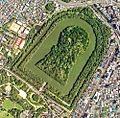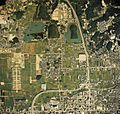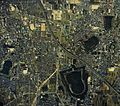Kofun facts for kids
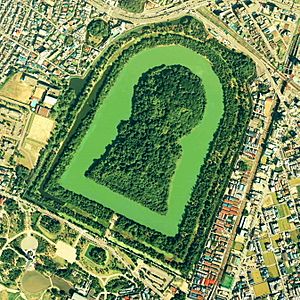
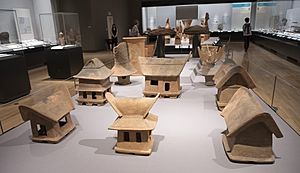
Kofun are giant ancient tombs or burial mounds found in Japan. People built them between the early 3rd century and the early 7th century AD. The word "Kofun" actually gave its name to the Kofun period, which lasted from the mid-3rd century to the mid-6th century.
Many Kofun have a special keyhole shape, which is unique to ancient Japan. Some of these Kofun groups, like the Mozu-Furuichi Kofun clusters, were added to the UNESCO World Heritage List in 2019. The Ishibutai Kofun in Asuka-Fujiwara is also being considered for this list.
What Do Kofun Look Like?
Kofun came in different shapes over time. The most famous type is called a zenpō-kōen-fun. This one looks like a keyhole from above, with one square end and one round end. There are also Kofun that are simply circular or square.
The direction Kofun face can be different. For example, in one group called Saki Kofun, all the round parts face north. But in another group, Yanagimoto, there's no set direction. Around these sacred areas, people placed Haniwa, which are special clay figures, to protect them.
Kofun can be very different in size. Some are only a few meters long, while others are over 400 meters long! The biggest one, believed to be for Emperor Nintoku, is called Daisen Kofun in Sakai City, Osaka Prefecture.
Inside the Kofun
The main burial room was usually under the round part of the Kofun. It was built with large stones. In 1972, an amazing discovery was made: the Takamatsuzuka Tomb in Asuka, Nara was found untouched! Inside, the walls were covered with white plaster and colorful paintings. These paintings showed court ladies, sometimes called the 'Asuka Beauties,' and even pictures of stars and constellations.
A stone coffin was placed in the burial room. People also put valuable items like jewelry, swords, and bronze mirrors both inside and outside the coffin. The wall paintings from Takamatsuzuka Tomb are now considered national treasures, and the items found inside are important cultural property. The burial mound itself is a special historic site.
Kofun burial mounds and their remains have been found all over Japan, even on faraway islands like Nishinoshima. As of 2001, more than 161,560 Kofun sites have been discovered! Hyōgo Prefecture has the most, with over 16,500 sites, and Chiba Prefecture is second with over 13,000 sites.
Related pages
- William Gowland, an English engineer who first surveyed the Saki Kofun group.
- Ernest Satow, an English diplomat who wrote about Kofun in Kozuke for the Asiatic Society of Japan.
Images for kids
-
Daisen Kofun, the largest of all kofun, one of many tumuli in the Mozu kofungun, Sakai, Osaka Prefecture (5th century)
-
The stone chamber of Ishibutai Kofun, said to be the tomb of Soga no Umako, Asuka, Nara Prefecture (7th century)
-
Panoramic view of Hashinaka Kofun in Sakurai, Nara
-
An example of a keyhole-shaped mound from the Early Kofun period (4th century), shown in 3DCG. This is the Gosashi Kofun in Nara, Nara.
-
An example of a keyhole-shaped mound from the Mid-Kofun period (5th century), shown in 3DCG. This is the Nakatsuyama Kofun in Fujiidera, Osaka.
-
An example of a keyhole-shaped mound from the Late Kofun period (6th century), shown in 3DCG. This is the Danpusan Kofun in Nagoya.
-
The Saki Tatanami Kofun Group and the Heijō-kyō site in Nara Prefecture, from the 4th century.
See also
 In Spanish: Kofun para niños
In Spanish: Kofun para niños





